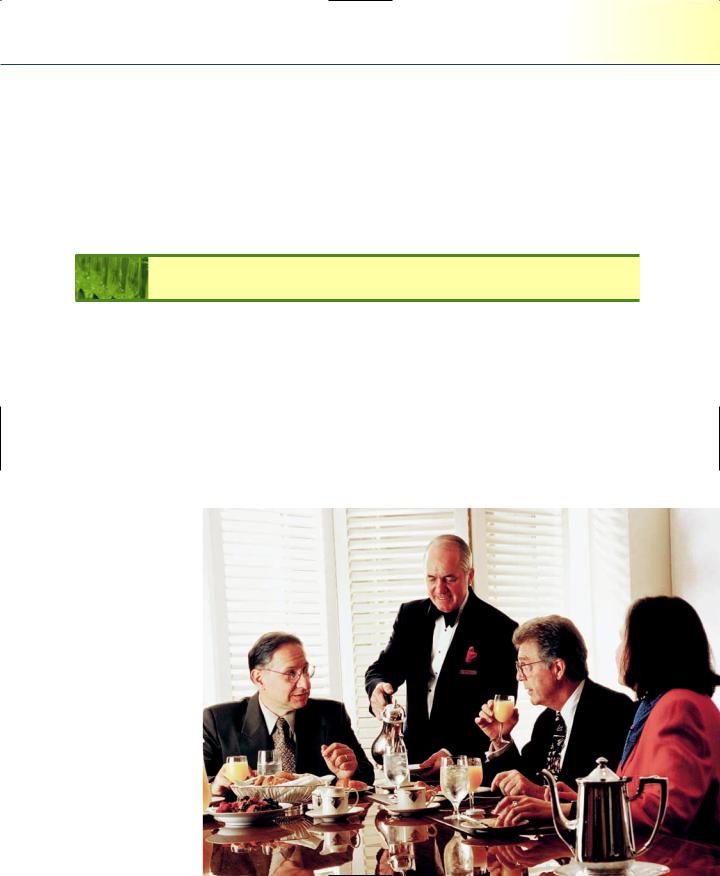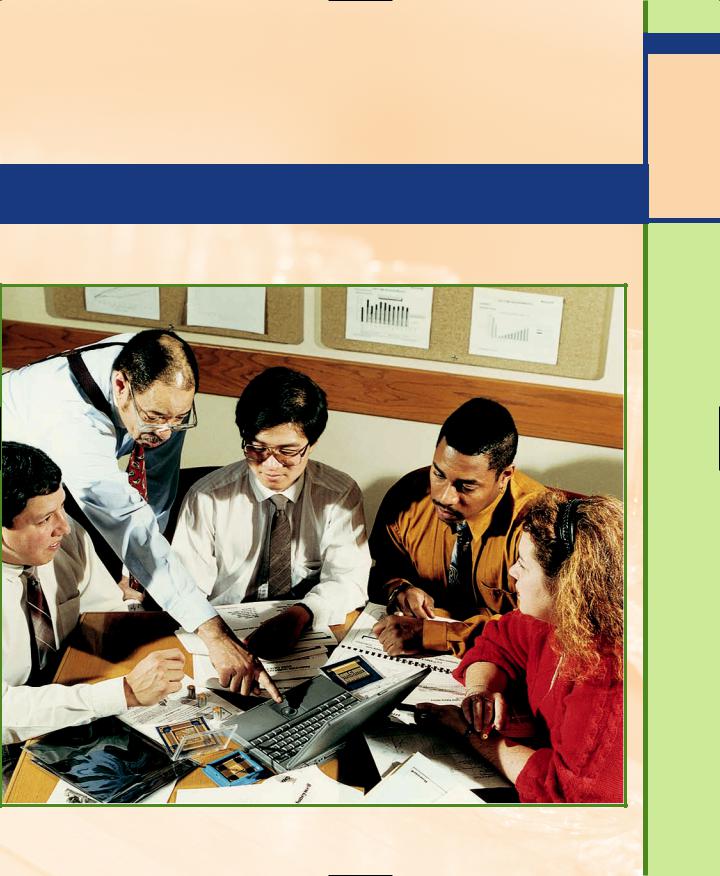
- •CONTENTS
- •PREFACE
- •Content—Benefits for Students
- •Content—Benefits for Instructors
- •Features of the Book for Students and Instructors
- •Supplementary Materials
- •Acknowledgments
- •What Is Hospitality Management?
- •The Manager’s Role in the Hospitality Industry
- •Why Study in a Hospitality Management Program?
- •Planning a Career
- •Employment as an Important Part of Your Education
- •Getting a Job
- •Employment at Graduation
- •The Outlook for Hospitality
- •Summary
- •Managing Change
- •Demand
- •Supply
- •Workforce Diversity
- •The Impact of Labor Scarcity
- •Summary
- •The Varied Field of Food Service
- •The Restaurant Business
- •The Dining Market and the Eating Market
- •Contemporary Popular-Priced Restaurants
- •Restaurants as Part of a Larger Business
- •Summary
- •Restaurant Operations
- •Making a Profit in Food Service Operations
- •Life in the Restaurant Business
- •Summary
- •Chain Restaurant Systems
- •Independent Restaurants
- •Franchised Restaurants
- •Summary
- •Competitive Conditions in Food Service
- •The Marketing Mix
- •Competition with Other Industries
- •Summary
- •Self-Operated Facilities
- •Managed-Services Companies
- •Business and Industry Food Service
- •College and University Food Service
- •Health Care Food Service
- •School and Community Food Service
- •Other Segments
- •Vending
- •Summary
- •Consumer Concerns
- •Food Service and the Environment
- •Technology
- •Summary
- •The Evolution of Lodging
- •Classifications of Hotel Properties
- •Types of Travelers
- •Anticipating Guest Needs in Providing Hospitality Service
- •Service, Service, Service
- •Summary
- •Major Functional Departments
- •The Rooms Side of the House
- •Hotel Food and Beverage Operations
- •Staff and Support Departments
- •Income and Expense Patterns and Control
- •Entry Ports and Careers
- •Summary
- •The Economics of the Hotel Business
- •Dimensions of the Hotel Investment Decision
- •Summary
- •The Conditions of Competition
- •The Marketing Mix in Lodging
- •Product in a Segmented Market
- •Price and Pricing Tactics
- •Place—and Places
- •Promotion: Marketing Communication
- •Summary
- •The Importance of Tourism
- •Travel Trends
- •The Economic Significance of Tourism
- •The United States as an International Tourist Attraction
- •Businesses Serving the Traveler
- •Noneconomic Effects of Tourism
- •Summary
- •Motives and Destinations
- •Mass-Market Tourism
- •Planned Play Environments
- •Casinos and Gaming
- •Urban Entertainment Centers
- •Temporary Attractions: Fairs and Festivals
- •Natural Environments
- •On a Lighter Note. . .
- •Summary
- •Management and Supervision
- •The Economizing Society
- •The Managerial Revolution
- •Management: A Dynamic Force in a Changing Industry
- •What Is Management?
- •Summary
- •Why Study Planning?
- •Planning in Organizations
- •Goal Setting
- •Planning in Operations
- •The Individual Worker as Planner
- •Long-Range Planning Tools
- •Summary
- •Authority: The Cement of Organizations
- •Departmentalization
- •Line and Staff
- •Issues in Organizing
- •Summary
- •Issues in Human-Resources Management
- •Fitting People to Jobs
- •Recruiting
- •Selection and Employment
- •Training
- •Retaining Employees
- •Staff Planning
- •Summary
- •The Importance of Control
- •Control and the “Cybernetic Loop”
- •Tools for Control
- •Summary
- •Leadership as Viewed by Social Scientists
- •Why People Follow
- •Leadership Theories
- •Communication
- •The Elements of Leading and Directing
- •Developing Your Own Leadership Style
- •Summary
- •A Study of Service
- •Rendering Personal Service
- •Managing the Service Transaction
- •How Companies Organize for Service
- •Summary
- •INDEX

Long-Range Planning Tools |
545 |
with the conviction that personal career goals need to be identified as early as possible (without an artificial forcing).
These goals may well dictate a policy of putting skill learning first and income second in choosing jobs while in college and perhaps for those first years out of college as well. This learn-first-earn-second strategy ensures practice. If income is more important (or essential), however, you may have to alter your strategy. Planning, policy, and strategy are not something somebody else does. No plan is more important to you than your own plan for yourself.
Long-Range Planning Tools
You can often plan for today and tomorrow “in your head.” The situation may be simple enough for you to grasp intuitively. However, when you make decisions that will have an effect for months or years, you need more sophisticated planning tools. These tools are usually considered at some length in courses on management accounting and finance. Moreover, we might properly include them in a later chapter on control. We will discuss them here, however, in order to emphasize the quantita-
tive side of planning.
Planning is carried out at every level of the organization. (Courtesy of Sodexho.)

546 |
Chapter 16 Planning in Hospitality Management |
RETURN ON INVESTMENT
When an organization makes an investment, it generally expects to earn that investment back within some definite period. Take the following simple situation: A new vacuum sweeper for use in public areas costs $2,000. The larger machine is more efficient, and it reduces the number of hours required to vacuum the area from 100 a month to 90. If the operator’s time costs $8 per hour, we can calculate two crude measures of value, and these measurements are common, simple decision aids. They are called the payback period and the return on investment. A useful formula is
P Payback period
OS Operating savings
NI Net investment
NI
P
OS
For our problem
OS 10 hours $8 $80 per month
and
$2000
P $80 month
P 25 months
Notice that we have specified the monthly savings, so the payback period is also expressed in months. These calculations tell us whether we can plan on this investment paying for itself in a reasonable period of time.
Another way of analyzing this problem is to determine the return on investment (ROI). Here, we just invert our formula, but the results are usually expressed in annual terms, and so the monthly savings in the previous problem are multiplied by 12.
OS $960.00
ROI
NI $2,000
0.48 or 48%
In a business in which money to invest is at a premium and many departments require funds for new equipment, these techniques give us the means to establish investment priorities. Most organizations have specific rules for investments that relate to return on investment. Thus, these calculations help to consider the purchase in the

Long-Range Planning Tools |
547 |
context of those rules, sometimes called hurdle rates. (The word hurdle is adopted from the track-and-field sports scene. The hurdle is something you have to be able to reach or surpass, much as a runner must clear the hurdle in a race.)
In more complex cases, a time-adjusted rate of return may be used as the hurdle. This tool recognizes that a dollar today is worth more than a dollar will be a year from now because of the interest today’s dollar can earn in a bank. The interest rate (called in these problems the discount rate) can be changed to reflect varying costs of capital and risk assumptions.
Another common quantitative planning tool is the break-even point computation. This technique is similar to the payback period method. Suppose a new banquet room is proposed. Management expects the banquet check average to be $9 and the banquet check food costs to be 33 percent. All other costs of the proposed banquet department are fixed. If the fixed costs (the monthly payroll; heat, light, and power; depreciation; and so forth) for this room amount to $15,000, how many banquet covers must be sold per month to cover the cost of the banquet room (in other words, to break even)? Our new formula follows:
BEP Break-even point
MR Marginal revenue (revenue less variable cost)
FC Fixed costs (the costs that will occur regardless of
volume of sales if the decision is made to go ahead)
S Sales
VC Variable cost
MR S VC $9 $3 $6
FC $15,000
BEP
MR $6.00
2,500 meals
Thus, 2,500 meals per month will cover all costs for this room. Management can now plan whether or not to build this room on the basis of its judgment about the number of meals it will probably serve.
COST-BENEFIT ANALYSIS
In business, the measure of dollar profit earned is not just useful—it is the principal decision-making guide. In school lunch or congregate feeding, however, such a measure is not enough. To begin with, revenue from guests is not always a significant

548Chapter 16 Planning in Hospitality Management
factor, because the cost of the program is covered by government funds. The program’s goal is not to earn a profit. Moreover, the decisions cannot always be measured in dollars. (In school lunch, how much is a hungry child worth?)
Although the variables cannot all be measured in dollars, a first step in costbenefit analysis (or cost-effectiveness analysis) is to make explicit those costs and savings that can be identified.
Suppose a congregate meals program is trying to decide whether to use 20 small feeding sites distributed throughout the county or to transport all its clients to a central point. The costs and savings to be specified would include the savings in food production and service staff in the central location and the reduction in food distribution expense (trucking food to 20 sites), in contrast with the cost of transporting clients to a central site.
Once this calculation is done, however, it is still necessary to weigh the possibility that some aged clients might not feel up to the long trip and that others might feel uncomfortable in a strange neighborhood. For these reasons, participation might decline. These problems would actually reduce costs and subsidies, but that is hardly what the staff wants! Planning in the public sector is sometimes more complicated than in private business, because not all costs and benefits have dollar values. Public programs, however, must still do their homework so they can report what cost effects result from changes in plans.
Goals and policies provide the basis for developing plans, both strategic and tactical. As the goals addressed relate to longer periods, however, those responsible for planning cannot rely on intuition. They must use more formal and often complex means of analysis.
To conclude, planning, strategy, and tactics are important at every level of the organization. At the top levels of the organization, leaders must plan for action—taking into consideration various expectations and the possibility of unforeseen events. As one final example, a recent report by the Conference Board asked several industry leaders about their top challenges and priorities in the upcoming years. Not surprisingly, many of them were directly related to planning and corporate strategy including: (1) sustained and steady top-line growth; (2) profit growth; (3) consistent execution of strategy by top management; (4) speed, flexibility, and adaptability to change and; (5) and customer loyatly and retention.5
Summary
Planning in organizations was the principal topic of this chapter. We first explained the reasons for planning and its different levels.
We defined and described several planning concepts: policies, plans, rules, methods, procedures, standards, budgets, strategies, and tactics.

Summary 549
Next, we discussed goal setting, and after defining and illustrating it, we turned to some of the subsets of goals. These included the characteristics of well-thought-out goals, goal congruence, and goals and policies.
Planning in operations requires strategy and tactics. We considered product and service strategies, human-resources strategies, and community relations strategies. We then gave an example of successful tactics.
The last section covered the individual worker as a planner, which we illustrated with examples of a server and a cook. We ended with a short discussion of planning as part of career preparation.
The long-term planning tools we explored were return on capital and cost-benefit analysis.
Key Words and Concepts
Planning |
Goal congruence |
Strategy |
Payback period |
Tactics |
Return on investment (ROI) |
Policies |
Rate of return |
Rules |
Break-even point |
Methods and procedures |
Cost-benefit analysis |
Standards |
Cost-effectiveness analysis |
Budgets |
|
Goal setting |
|
Review Questions
1.Outline some of the reasons why you should study planning.
2.Define policies, plans, rules, methods, procedures, standards, budgets, strategies, and tactics.
3.What are the five questions that might be asked when setting goals?
4.What does goal congruence mean? What is the importance of this concept?
5.Is planning part of your study habits? Explain.
Internet Exercises
1.Site name: Starwood Hotels & Resorts Worldwide, Inc.
URL: www.starwood.com/corporate/company_info.html
Background information: Starwood is one of the world’s largest hotel and leisure
companies. The company’s brand names include St. Regis, The Luxury Collection,

550 |
Chapter 16 Planning in Hospitality Management |
Sheraton, Westin, W, and Four Points by Sheraton. Through these brands, Starwood is well represented in most major markets around the world. The company’s operations are grouped into two business segments, hotels and vacation ownership operations.
Exercises:
a.What are the goals and objectives (business strategy) of Starwood?
b.What are their competitive strengths?
c.Is there goal congruence (organizational goals and individual employee goals mesh rather than clash) at Starwood?
2.Site name: Accor
URL: www.accor.com/gb/groupe/accueil.asp
Background information: With 158,000 associates in 140 countries, Accor is the
European leader and one of the world’s largest groups in travel, tourism, and corporate services, with two major international activities: Hotels and Services.
Exercises: Compare the Accor and Starwood Web sites
a.Which company provides more information on its goals and objectives?
b.Which company identifies their role in employee and community relations as part of their business strategy?
c.Since environmental issues are very important, what plans do these companies have to sustain the environment?
3.Site name: Alliance for Nonprofit Management
URL: www.allianceonline.org/FAQ/strategic_planning
Background information: The Alliance for Nonprofit Management is the professional
association of individuals and organizations devoted to improving the management and governance capacity of nonprofits. The alliance is dedicated to assisting nonprofits in fulfilling their missions.
Note: Nonprofit organizations are private organizations whose primary objective is to benefit their members or people within society by supporting an issue of private interest or other endeavor for the public good. Even though their mission is not to generate a profit, all the functions of management still apply because nonprofits must still generate income to meet their expenses. Among the many nonprofit organizations related to hospitality are the following: Chefs for Humanity (www.chefsforhumanity.org), Share Our Strength (www.strength.org), Meals on Wheels (www.mowaa.org), and City Harvest (www.cityharvest.org).
Site name: The Free Management Library: Planning in Organizations
URL: www.managementhelp.org/plan_dec/plan_dec.htm
Background information: The Free Management Library provides easy-to-access, clut- ter-free, comprehensive resources regarding the leadership and management of

Summary 551
yourself, other individuals, groups, and organizations. The content is relevant to the vast majority of people, whether they are in large or small for-profit or nonprofit organizations. Over the past ten years, the library has grown to be one of the world’s largest and best-organized collections of these types of resources.
Site name: QuickMBA
URL: www.quickmba.com/strategy/strategic-planning/
Background information: QuickMBA is an online knowledge resource for business administration. The goal is to help you to quickly find the business knowledge you need, when you need it, wherever you may be. Topics are presented as frameworks and summaries in the various subjects of business administration, as taught in the world’s top MBA programs.
Exercise:
a.Choose one of the “chapters” on any of the three Web sites above that is of interest to you. Lead a class discussion on the management function of “planning” in an organization and describe why this information would be important to a hospitality manager.
Notes
1.Bryan G. Herron, “Strategic Planners or Restaurateurs...One and the Same?” Proceedings of the 12th Annual Chain Operators Exchange (Chicago: International Foodservice Manufacturers Association, 1985).
2.Wall Street Journal, May 14, 1993, p. B4. and May 19, 1994, p. B6.
3.For the best statement of this point of view, please see Peter Drucker’s work, particularly
Management: Tasks, Responsibilities, Practices (New York, Harper & Row, 1974).
4.For an excellent and witty discussion on this point, see Robert Mager and Peter Pipe,
Analyzing Performance Problems or You Really Oughta Wanna ((Belmont, CA: Fearon Publishers, 1970).
5.CEO Challenge 2006, Conference Board of Canada, June 2006.

The Hospitality Industry
(Courtesy of Honeywell, Inc.)

C H ACPHTAE PR TSEERV OENTEE E N
OrganizingTheHospitalityin Hospitality
IndustryManagementand You
The Purpose of this Chapter
his chapter discusses the way people come together to work, an enjoyable and interesting sub-
Tject. In a “society of institutions,” to use Peter Drucker’s words, knowing how institutions get put together can also help guide both work and life. Working relationships are rarely arbitrary. Moreover, an understanding of the limits of authority—and the limits on accepting authority—is essential
to someone building a career in managing and supervising others. We are all on the receiving end of organizational decisions and the exercise of authority from time to time. So the basic argument is that understanding how management organizes will help you polish your hospitality management skills.
THIS CHAPTER SHOULD HELP YOU
1.Explain how a manager should respond to the leadership of informal work organizations within a formal work group.
2.Name two sources of authority within the workplace, explain them, and state their limits.
3.List five common bases for dividing work into organizational units/departments, and name a specific segment of the hospitality industry likely to use each basis.
4.Describe line management and staff assistance functions, and explain the differences in authority that each exercises.
5.Explain the advantages and disadvantages of the following elements of organization theory and practice: the roles of committees, bureaucracy, and the one-boss theory.
